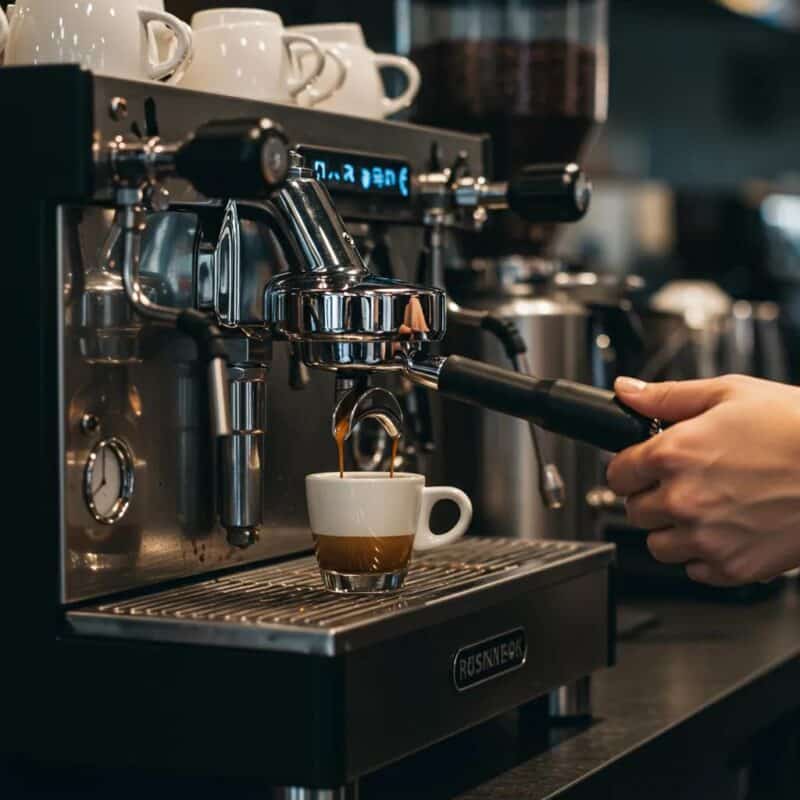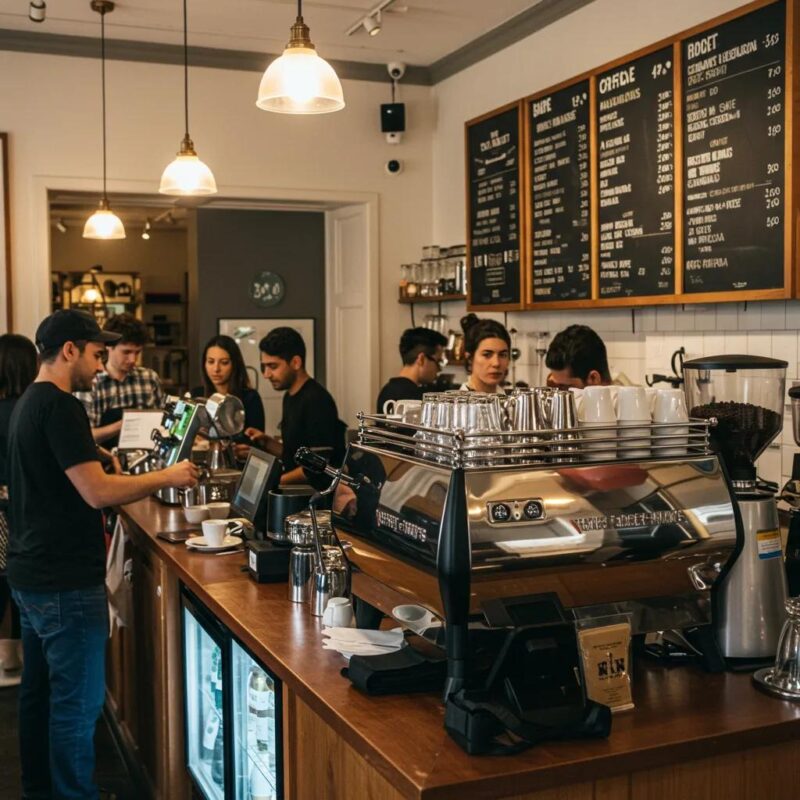
Bean-to-Cup vs Traditional Espresso Machines: Which Is Best for Your Office or Coffee Shop?
A growing number of businesses face a crucial choice: should they invest in bean-to-cup machines or opt for traditional espresso equipment? Selecting the right coffee system influences operational efficiency, beverage quality, and staff training. This guide will dissect both machine types, compare their core features, explore ideal business scenarios—from small offices to specialty cafés—and highlight emerging UK market trends. You will learn how each system automates or manualises brewing and frothing, which environments they suit best, and what maintenance, cost and sustainability considerations to weigh before deciding.
What Are Bean-to-Cup Coffee Machines and Their Key Features?
Bean-to-cup coffee machines are super-automatic brewers that grind whole beans, extract espresso and froth milk with one touch, delivering consistency and speed. By incorporating an integrated grinder, pump system and milk-steaming module, these machines simplify barista tasks and reduce human error. For example, a modern office break-room model can yield a flat white or latte in under a minute with identical strength each time.
Key features of bean-to-cup machines include:
- Built-in Conical Grinder: Freshly grounds beans to precise fineness for optimal extraction.
- Programmable Drink Profiles: Customises shot volume, water temperature and milk texture via touchscreen.
- Automatic Cleaning Cycles: Flushes brewing group and milk circuit to maintain hygiene.
- Compact Footprint: Ideal for self-service stations with minimal counter space.
These attributes underpin high consistency in every cup and require minimal staff training, setting the stage for streamlined office and self-service environments.
How Do Bean-to-Cup Machines Automate Coffee Brewing and Milk Frothing?
Bean-to-cup machines automate the entire coffee preparation process by linking grinder, boiler and milk system into a closed workflow. When a drink selection is made, beans pass through the grinder, the machine automatically tamps and doses grounds into a brewing chamber, then forces hot water through at controlled pressure. Immediately afterward, an integrated steam wand or milk circuit froths milk to preset microfoam levels. This end-to-end automation ensures each espresso shot and milk-based drink follows the same extraction and texture parameters.
Automated brewing reduces operator variability and significantly speeds up drink delivery. Because sensors monitor grind fineness, tamp pressure and water temperature, the machine self-adjusts to maintain taste stability. The result is consistent crema thickness and balanced flavour, whether you prepare a short ristretto or a creamy cappuccino.
Automating Workflows for Enhanced Bean-to-Cup Coffee Experiences
Automating workflows must be balanced with careful change management, delivering the most rapid bean-to-cup experience within the industry. By…The Pillars of the Total Experience, Unknown Author, 2025
What Are the Benefits of Bean-to-Cup Machines for Offices and Self-Service?
Bean-to-cup machines excel in high-turnover, low-training environments by offering:
- Ease of Use – One-touch operation lets staff and visitors serve themselves without barista skills.
- Uniform Quality – Automated dosing and extraction deliver repeatable taste across hundreds of cups.
- Speed and Throughput – Typical brew times under 60 seconds support peak-hour demand.
- Low Supervision – Built-in cleaning programs minimise daily maintenance tasks.
These benefits translate into satisfied employees and reduced overhead for on-site support, making bean-to-cup ideal for corporate lounges, co-working spaces and hotel breakfast bars.
Which Business Environments Are Ideal for Bean-to-Cup Machines?
Bean-to-cup models thrive where self-service and consistency outweigh artisanal craft. Typical settings include:
- Medium to large offices with fluctuating staff numbers.
- University common rooms and staff rooms requiring rapid, hands-free operation.
- Conference and meeting venues where operator training is impractical.
- Retail or convenience outlets offering basic coffee selection without barista staffing.
In these contexts, minimal training and uniform beverage quality drive productivity and customer satisfaction.
What Are the Maintenance Requirements and Costs of Bean-to-Cup Machines?
Bean-to-cup maintenance involves periodic tasks and running-cost considerations:
- Daily Rinse Cycles: Automated flush of brewing chamber and milk circuits.
- Weekly Descaling: Removal of mineral buildup from water paths.
- Bean Hopper and Waste Drawer: Routine emptying and cleaning.
- Consumables: Replacement of water filters, cleaning tablets and milk-system brushes.
On average, maintenance time per week is under 30 minutes and annual running costs range from 5–10% of purchase price. These manageable demands reinforce self-sufficiency in busy office or low-staff environments.
How Do Traditional Espresso Machines Work and What Are Their Advantages?

Traditional espresso machines rely on manual barista skill to grind, tamp, extract and steam, offering hands-on control over every shot. A barista measures ground coffee, applies precise tamp pressure into a portafilter, attaches it to the group head, and initiates pre-infusion and extraction via lever or switch. For milk-based drinks, a stainless-steel steam wand requires manual positioning and skillful frothing to achieve microfoam.
This manual workflow rewards trained operators with:
- Fine-Tuned Customisation – Baristas can adjust grind size, brew time and pressure for unique flavour profiles.
- Espresso Quality – Skilled technique produces richer crema, flavour nuance and aromatic complexity.
- Latte Art Capability – Manual steaming allows artful presentation that elevates customer experience.
- Multi-Group Potential – Dual or triple group heads support simultaneous drinks in specialty cafés.
By leveraging barista expertise, traditional machines deliver artisanal beverages and interactive theatre.
What Level of Barista Skill Is Needed for Traditional Espresso Machines?
Using a traditional machine demands a foundational barista skill set:
- Manual Grinding and Dosing: Calibrating grinder settings for consistent particle size.
- Tamping Technique: Applying even 30 lb pressure to ensure uniform extraction.
- Extraction Control: Observing shot timing and flow to achieve balanced espresso.
- Steam Wand Mastery: Positioning and aerating milk to create silky microfoam for latte art.
Barista training often spans several weeks, followed by ongoing practice to maintain speed and consistency during peak service.
How Do Traditional Machines Offer Customisation and Quality Control?
Traditional espresso machines grant granular control over brewing variables:
- Grind Size Adjustment: Facilitates dialling in extraction for single-origin beans or blends.
- Pre-Infusion Timing: Saturates grounds gently before full pressure to improve crema extraction.
- Pressure Profiling: Manual levers or programmable pumps enable pressure ramps for flavour clarity.
- Steam Wand Positioning: Enables varied foam textures for cappuccinos, macchiatos or flat whites.
Such flexibility supports premium coffee menus and niche beverage experimentation, ensuring each cup meets exacting quality standards.
Which Coffee Shops and Businesses Benefit Most from Traditional Espresso Machines?

Traditional machines suit environments where craftsmanship and custom orders matter:
- Specialty cafés focusing on single-origin and barista-crafted beverages.
- High-end restaurants offering paired coffee courses and tasting experiences.
- Hotel lounges with dedicated baristas delivering personalised service.
- Busy urban cafés requiring multi-group heads to handle sustained peak-hour volume.
In these settings, the investment in skilled staff and professional equipment yields elevated coffee profiles and customer loyalty.
What Are the Maintenance and Training Costs for Traditional Espresso Machines?
Maintenance and training for traditional machines are more intensive:
- Daily Backflushing: Cleaning group heads with detergent to remove oils and residues.
- Steam Wand Sterilisation: Wiping and purging after each service shift.
- Professional Servicing: Quarterly calibration of boilers, pumps and safety valves.
- Staff Training: Barista courses costing several hundred pounds per person.
Annual upkeep can reach 15–20% of the machine’s purchase price, and training adds further fixed costs—but the payoff lies in premium beverage quality and brand differentiation.
What Are the Main Differences Between Bean-to-Cup and Traditional Espresso Machines?
Understanding key contrasts helps match machine to business goals:
| Feature | Bean-to-Cup Machine | Traditional Espresso Machine |
|---|---|---|
| Automation Level | Fully automatic from grind to froth | manual grinding, tamping and steaming |
| User Skill Required | Minimal training, intuitive touchscreen | Extensive barista expertise and practice |
| Beverage Consistency | High consistency via sensors and presets | Variable depending on operator skill |
| Throughput Time | Under 60 s per drink | 90 s–2 min depending on workflow |
| Customisation Flexibility | Limited to preset profiles | Infinite tweaks on grind, pressure, timing |
| Initial and Running Costs | Moderate purchase; low upkeep | High purchase; substantial maintenance |
| Maintenance Routine | Automated cleaning; periodic descaling | manual backflushing; detailed servicing |
| Customer Experience | Self-service convenience | Barista theatre and bespoke service |
How Do Bean-to-Cup and Traditional Machines Compare in Ease of Use and Training?
Bean-to-cup machines feature one-touch menus and guided cleaning cycles that require under 15 minutes of initial user instruction. Traditional machines demand several weeks of barista training in grinding, tamping and steaming, making them less suitable for high-turnover or non-specialist staff.
Which Machine Type Delivers Better Coffee Quality and Consistency?
Automated dosing and precise temperature control enable bean-to-cup systems to deliver consistent medium-strength espresso. However, a skilled barista on a traditional machine can coax out richer crema, nuanced flavour notes and tailored extraction profiles that surpass basic automatic parameters.
How Do Speed and Volume Capacity Differ Between the Two Machine Types?
Bean-to-cup machines typically brew single servings in 45–60 seconds and handle moderate office demand efficiently. Traditional multi-group heads can serve three drinks concurrently, accommodating peak café rushes, but require coordinated barista workflow to maintain speed.
What Are the Differences in Customisation and Drink Variety Options?
Bean-to-cup profiles are limited to programmed recipes—usually espresso, americano, latte and cappuccino—whereas traditional machines empower baristas to invent signature beverages, adjust shot strength on-the-fly and perform latte-art embellishments.
How Do Initial Costs and Running Expenses Compare?
Bean-to-cup systems cost £2,000–£8,000 upfront, with annual running expenses around £300–£800. Traditional machines start at £5,000 for single-group models and can exceed £15,000 for premium multi-group setups, plus maintenance and training reaching £1,000–£3,000 yearly.
What Are the Maintenance and Cleaning Differences?
Automated rinse and descaling routines on super-automatic machines mean under 30 minutes of weekly upkeep. Traditional machines require daily backflushing, steam-wand purges and professional servicing every 3–6 months, amounting to more frequent manual intervention.
How Do Aesthetics and Customer Experience Vary?
Modern bean-to-cup units present sleek, uniform interfaces ideal for self-service counters, while traditional espresso machines showcase polished portafilters, steam wands and group-head levers that enhance café ambience and customer engagement.
Which Coffee Machine Is Best for Your Office Environment?
Selecting the ideal office coffee solution depends on convenience, budget and employee expectations.
Why Are Bean-to-Cup Machines Ideal for Office Convenience and Efficiency?
Bean-to-cup machines offer intuitive one-touch menus and automated cleaning that allow any staff member to prepare a cappuccino or flat white in under a minute. Consistent beverage profiles reduce complaints over weak or overly bitter coffee, while integrated grinders ensure fresh flavour without separate equipment.
How Should Office Size and Budget Influence Your Coffee Machine Choice?
Small offices (under 20 users) may favour entry-level bean-to-cup units costing around £2,500 with minimal footprint. Larger organisations (50+ employees) benefit from mid-range models (£5,000–£8,000) featuring dual bean hoppers and higher throughput. Traditional machines rarely suit offices unless dedicated barista staffing and training budgets exist.
What Are the Key Considerations for Employee Satisfaction and Coffee Quality in Offices?
Balancing ease of use with taste expectations means choosing a bean-to-cup model that allows strength and temperature adjustments. Offering milk-free and decaf options enhances inclusivity. Regular maintenance schedules and accessible user guides further boost employee satisfaction and reduce service interruptions.
Which Espresso Machine Suits Your Coffee Shop or Specialty Café?
Café owners must weigh quality, workflow and guest experience when selecting equipment.
Why Do Coffee Shops Prefer Traditional Espresso Machines for Quality and Craftsmanship?
Traditional machines empower baristas to fine-tune extraction profiles, showcase latte art skills and engage customers at the counter. The tactile process of grinding, tamping and steaming adds theatre that reinforces a specialty café’s artisanal brand.
How Do Traditional Machines Handle High Volume and Custom Orders?
Multi-group heads enable simultaneous preparation of multiple espressos, while dual boilers allow brewing and steaming in parallel. Skilled baristas can juggle custom recipes—such as single-origin pours or specialty milk alternatives—without sacrificing service speed.
Can High-End Bean-to-Cup Machines Meet Coffee Shop Demands?
Premium super-automatic machines with advanced grinders, pressure profiling and milk-texturing attachments can approach café-level output. They streamline self-service during off-peak hours and reduce staff requirements, though they still lack full latte-art flexibility and barista-led customisation.
What Ancillary Equipment Complements Espresso Machines in Coffee Shops?
Essential accessories include:
- Commercial Grinders: Stepped or stepless burr grinders for precise dosing.
- Tamper Stations: Ergonomic bases and calibrated tampers for consistent pressure.
- Knock Boxes: Durable waste receptacles for spent pucks.
- Milk-Jets and Jugs: Stainless-steel pitchers and automatic frothing nozzles.
- Water Filtration Systems: Inline filters to protect boiler longevity and taste.
These tools support barista efficiency and elevate beverage quality under high-volume conditions.
What Are the Latest Industry Trends and Future Outlook for Commercial Coffee Machines?
Staying ahead of market shifts helps businesses future-proof their coffee investments.
How Is the UK Coffee Machine Market Growing and Evolving?
As of October 2025, the UK commercial coffee equipment sector is projected to expand at a 5.6% CAGR through 2035, reaching over USD 1.02 billion in value. Rising demand for speciality coffee and workplace amenities fuels growth in both bean-to-cup and traditional espresso segments.
What Technological Innovations Are Shaping Bean-to-Cup and Traditional Machines?
Key advancements include:
- IoT Connectivity: Remote monitoring of machine health and usage analytics.
- Pressure Profiling Modules: Electronic pump control for custom extraction curves.
- Touchscreen Interfaces: User-friendly recipe customization and maintenance alerts.
- Automated Milk-Frothing Arms: Adaptive steam nozzles that replicate barista techniques.
These innovations enhance uptime, product consistency and user experience.
How Are Sustainability and Environmental Concerns Influencing Coffee Machine Choices?
Energy-efficient boilers, recyclable coffee grounds collection, and reduced water consumption are top priorities. Manufacturers now offer eco-mode settings, biodegradable cleaning tablets and modular designs for easier component replacement, aligning with corporate sustainability goals.
What Design Trends Are Popular in Commercial Coffee Machines?
Minimalist lines, matte finishes and compact modular layouts dominate modern break-room and café interiors. Integrated LED lighting and customizable panels allow brands to personalise machine aesthetics, creating visually cohesive service counters.
What Are Common FAQs About Bean-to-Cup vs Traditional Espresso Machines?
Businesses often ask focused questions to guide purchasing decisions.
What Is the Main Difference Between Bean-to-Cup and Traditional Espresso Machines?
The main difference lies in automation versus manual control: bean-to-cup machines automate grinding, brewing and frothing for consistency and speed, while traditional espresso machines rely on barista skill for bespoke extraction, flavour nuance and latte art.
Which Machine Type Is Better for Offices?
For offices, bean-to-cup machines are generally better due to their one-touch operation, minimal training requirements and reliable drink consistency, making them ideal for self-service environments with variable staff expertise.
Can Bean-to-Cup Machines Produce Barista-Quality Coffee?
High-end bean-to-cup models can approach barista-quality espresso by using precision grinders and temperature control, but a skilled barista with a traditional machine typically achieves superior crema richness and customised flavour profiles.
What Are the Disadvantages of Bean-to-Cup Machines?
Limitations of bean-to-cup machines include:
- Restricted customisation beyond preset recipes.
- Complex internal mechanisms requiring specialised servicing.
- Higher acquisition cost for models with advanced profiling features.
What Are the Disadvantages of Traditional Espresso Machines?
Traditional machines present challenges such as:
- Extensive barista training and labour costs.
- Greater manual maintenance and daily cleaning routines.
- Inconsistent quality when operated by less-experienced staff.
In sum, the optimal choice hinges on whether your business prioritises speed and uniformity or artisanal quality and customisation.
